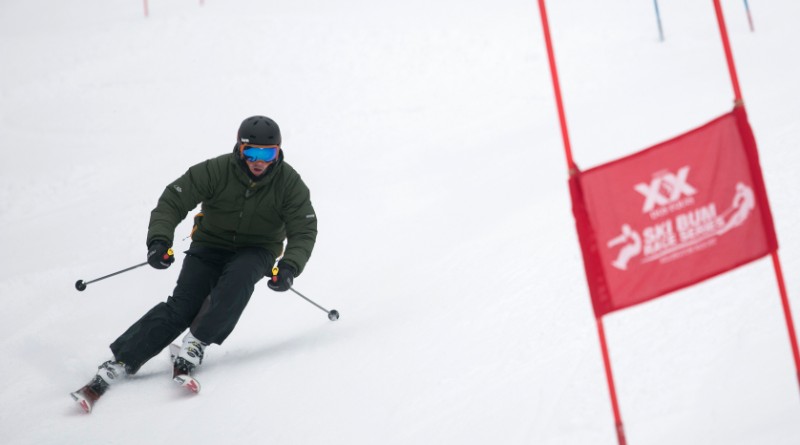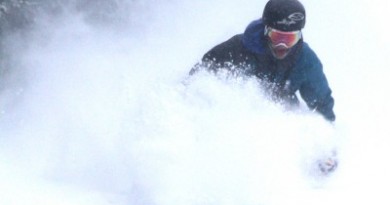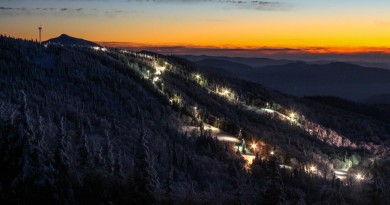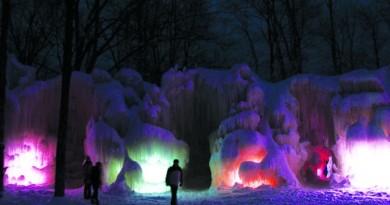No Experience Necessary: Ski bum races offer racing glory for all
The Middlebury College Snow Bowl attracts racers of all ages and abilities for light-hearted races that help build the community.
Photo by Killington Resort
Hancock — On a bitter January afternoon, the light on the lower portion of Middlebury College Snow Bowl’s Allen run is growing flat as flurries of snow sweep across the mountain face in bone-chilling gusts. The icy chill reflects the surface conditions as well. It’s Vermont hard pack; better sharpen your edges if you want a grip.
For some, conditions might warrant skipping the afternoon, but in a wooden shack concealed by a stand of trees, a group of ski racers shuffle their way up to a starting gate, ready for their runs down a winding giant slalom course.
One at a time, under direction of the course marshal, they plant their poles and explode down the hill toward the first gate, buffeting in the wind.
Jim and Margaret Eagan ski recreationally and have been competing in the league for the past four years. The two live in neighboring Salisbury and ski at the Snow Bowl regularly. While the two describe themselves as recreational skiers, they still enjoy coming to the Snow Bowl every Friday afternoons to race in the mountain’s Ski Bum League.
“Neither of us are really racers,” says Margaret. “But racing is a good indicator of your skiing technique. It’s one thing to be able to ski fast when you’re skiing on your own, but you have to be much more precise on a race course.”
Now in its ninth season, the Middlebury Snow Bowl Ski Bum Races attracts teams of at least four every Friday. Team names include such description monikers as “Down the Hill – Not Over It,” “Apres-Nordorks,” “The Gatekeepers,” “The Frothy Walruses,” and “Easy Riders.” Racers include long-time skiers who may have raced in programs through high school or club teams, to collegiate skiers and semi-pro, to recreational skiers who are racing for the first time.
Holmes Jacobs, who helped start the league nine years ago, says the weekly races attract skiers of all ages and abilities.
“It ranges from five-year-olds to 75-year-olds,” he says. “There are former Olympians, there are people who have barely ever skied. It’s all ages and abilities. It’s all very casual and it builds a sense of community and camaraderie.”
The weekly races at the Snow Bowl are a microcosm of a scene going on throughout the state. Every winter, skiers and snowboarders of all levels click into their bindings or strap on their boards every week and take to the course at their favorite hill in pursuit of a faster time, bragging rights and maybe a gift certificate to a local restaurant as well.
In Stowe, Marion Baraw says if there’s anything that can bring people of all ages, incomes and professions together, it’s skiing.
“It’s part of the magic of the sport and I call it the Peter Pan syndrome,” she says. “You never grow up. After the races, the 20-year-olds are hanging out with the 76-year-olds.”
The Mount Mansfield Ski Club (MMSC) was established in 1920 and has a long history with athletes and coaches competing on the national and international skiing stages. But local skiers, snowboarders and tele-skiers don’t have to train for world class racing to experience the thrill of competition. On Tuesdays, more than 100 skiers and riders gather at the slopes at Stowe Mountain Resort to take on a head-to-head GS-style course for a weekly series of races. This year’s youngest racer is 20. The oldest is 76.
Baraw has been organizing the races at the Mount Mansfield Ski Club since their start 45 years ago, earning her the unofficial title, “Queen of the Ski Bum Races.” Having helped with the races since their start, Baraw credits the race’s established handicap system that levels the playing field. Racers can only improve by a maximum of 20 points per week. In the past two years the volunteers that run the races have developed a computerized program that takes race results and reconfigures everyone’s handicap for the following week – a much faster system than when Baraw used to configure the points and each racer’s score and handicap on paper.
Bud McKeon, owner of the Fiddler’s Green Inn in Stowe has been competing in the series since 1972, when he and a group of coworkers created a team. The competition was great and the parties that followed were even better. After over 30 years of racing with the club, he’s still taking to the slopes to crash gates with all levels of skiers and riders.
“It’s always a laugh when you beat someone you shouldn’t have and you get to rub it in their face,” he says with an added laugh.
Following the races, there’s always a party at a local establishment and participants can win all kinds of prizes.
“You’re bound to win something,” he says. “You might win a gift certificate for wings at the Sunset Grille or dinner for two at the Stoweflake Resort. You never know.”
Beer and prizes aside, McKeon says the other reason people should consider joining their local ski bum series is for the ability to improve their skiing. Because points are assigned based on how much teams improve each week, McKeon says, the better skiers have a higher handicap, which levels the playing field for the rest of the group.
“That’s why it’s better to have a good mix [of skiing abilities],” he says. “It doesn’t matter if you’re a lousy skier, you can still get more points than someone who finishes first. That’s the way it’s always been programmed. It’s inclusive and not just for people who are really good racers.”
That’s not to say that Stowe doesn’t see its share of high-caliber racing talent. McKeon remembers in the ’80s when members of the Austrian Olympic team, who were working at Stowe Mountain Resort as ski instructors, used to join the locals for the races. They dominated, of course.
At Killington, over 200 alpine and telemark skiers and boarders organize every year into teams for a race series operated by the Killington Ski Club. The 14-race series runs until late March, with new teams entering every week in two divisions. Chuck Hughes, events manager for the Killington Mountain School says even Killington president, Mike Solimano, competes on a team.
While Stowe uses a handicap scoring system, Killington employs a system of “A” and “B” levels in men’s and women’s categories in alpine and telemark skiing and snowboarding.
“If you clobber the field by a certain margin we move you into the next category,” Hughes explains. “That way it’s fair. If you do win the category in the B section, we move you to the A section in the next year. That way you can’t be reigning B champion two years in a row.”
You don’t have to have any racing experience, but you do have to be 21 to join (and to enjoy the Dos Equis specials at the ski bum parties that follow).
At Sugarbush, racing lasts all winter with the Sugarbush Racing Club, a group of adults who are living (or re-living) their ski bum days on the slopes of Sugarbush and in the Mad River Valley. The club competes Thursdays on Sugarbush’s NASTAR course in a dual giant slalom format.
For skiers in southern Vermont, Mount Snow’s own Valley League runs until March on the Charlie’s Chase course. New this year, racers do not have to be on a team and can race as a free agent. The Innkeepers Series of races at Bromley is well underway this winter, with teams going head-to-head on Lord’s Prayer. If you don’t have a team or can’t commit to a whole season, check out the Mountain Dew Vertical Challenge, a fun series of free races throughout the Northeast including stops at Okemo, Killington, Q Burke and more.
Back at the Snow Bowl, after the lifts have stopped turning and the sun sets, skiers head back down Route 125 into downtown Middlebury, where they retire to the Two Brothers Tavern for some après-ski food, drink and camaraderie. Organizers raffle off gift certificates and everyone sticks around for another beer or some more chicken wings, greeting friends and making new ones. It’s a friendly atmosphere that for many is a main reason for participating in this kind of a racing event.
Gordie Eaton, 75, from Middlebury, started racing in high school, won the NCAA downhill championship as a racer for Middlebury College and went on to ski on the 1960 US Olympic Team and World Championship in 1962, before helping coach the 1968 U.S. Olympic team. Today, he competes on a ski bum team with his son, Chris, who’s one of the fastest on the hill. Gordie is a few seconds behind him these days, but still beats most of the crowd. While he says he enjoys the skiing and seeing his team’s score at the end, the whole point is the good times that come with it.
“Ski racing is fun in itself,” he says. “The best thing about skiing is you get a few runs in and hang out with people. Skiers always want to have a good time and that’s what we do.”




